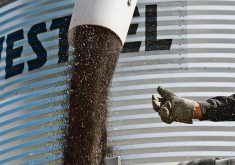As a new grower, Joel Comer looked to a co-operative to help launch his fledgling operation.
The Creston, B.C., producer is one of 20 members of the Naturally Grown Herb and Spice Producers Co-operative.
He and his wife are university graduates who have returned to his parents’ former cattle farm with plans to create an operation that includes honeybees, pigs, chickens and burdock.
“For us, having a really diverse operation on your farm creates stability,” he said.
“Having burdock and working with a co-operative is another segment of a diverse farm.”
Read Also

Alberta cracks down on trucking industry
Alberta transportation industry receives numerous sanctions and suspensions after crackdown investigation resulting from numerous bridge strikes and concerned calls and letters from concerned citizens
Burdock, which is used as a flour replacement and general tonic, will be planted on top of 300 waste bales.
That allows for easy access to the roots at harvest and also prevents the invasive species’ spread to his and nearby farms.
Joining a co-operative allows small producers like Comer to produce enough to satisfy manufacturers’ demands.
He said other benefits include sharing equipment, education, funding to pay for food safety training and the board of directors’ knowledge and support.
“Having a co-op there to do the marketing creates opportunities out of nothing,” said Comer.
The British Columbia group is one of a diverse array of co-ops across Canada that are being celebrated as part of the United Nations international year of co-operatives.
More than 9,000 co-ops operate in Canada with 18 million members. The Canadian Co-operative Association reports that co-ops employed more than 155,000 Canadians last year and held assets of more than $370 billion.
The herb and botanical co-op does primary processing, direct sales to manufacturers and value-added development, said president Jeanette Lee.
She said the 20 growers create enough volume and a consistent supply for manufacturers and provide assurances on food traceability and how food is collected.
“A single grower typically can’t produce enough for a manufacturer,” said Lee, who grows herbs and botanicals such as hawthorn, cascara sagrada, birch, fungi and elderberries near Edgewood, B.C.
The co-op runs a website and organizes forums where members can discuss diseases, cultivation, organic principles, policy and procedures. Training workshops cover topics such as value chains and on-farm food safety.
Lee said members don’t need to be certified organic, but must incorporate organic principles into their growing practices.
The group is working on developing hawthorn-based products with the University of Toronto and Royal Ontario Museum, which is considered an authority on the plant.
The universities of Alberta, British Columbia and Okanagan and the British Columbia Institute of Technology are conducting trials and measuring and isolating the plant’s chemical compounds.
Lee said the goal is to combine hawthorn into medicinal products and measure whether Canadian hawthorn is equivalent or superior to hawthorn grown in other parts of the world.
Lee said the co-op promotes environmental sustainability and biodiversity by intercropping. The abundance of hawthorn in the province makes it a natural choice for propagating and developing plant stock for the agro forestry industry.














